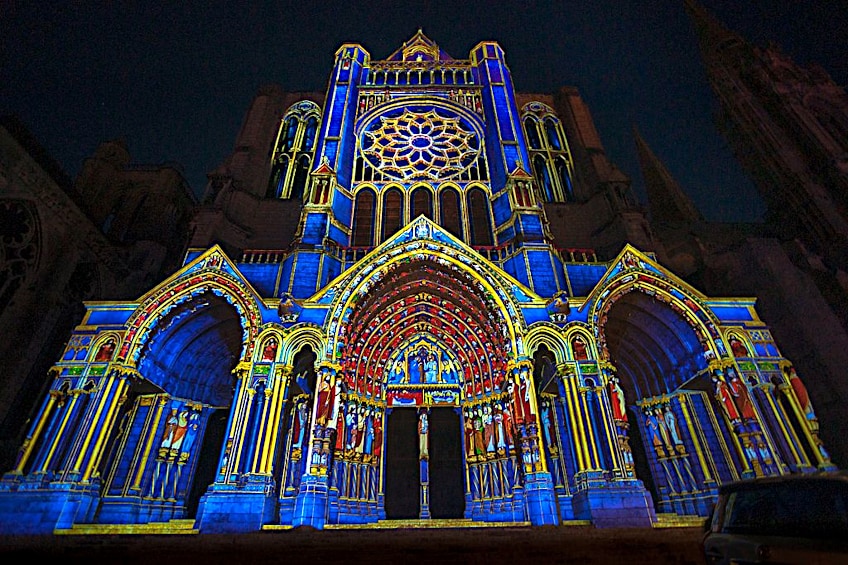Chartres Cathedral – A Spiritual and Architectural Masterpiece
The Chartres Cathedral is an immensely important and influential piece of High Gothic architecture that has managed to remain in its present state for centuries. This article will look at some of the characteristics of this particular cathedral, the holy relic within its walls, the elaborate labyrinths that exist on both the interior and the exterior of the structure, and it will end off with a look at a history of the cathedral as a whole. So, keep reading to learn more about the Cathedral of Chartres and its immense influence on other pieces of Gothic architecture!
Contents
- 1 A Look at the Chartres Cathedral
- 2 The History of the Chartres Cathedral
- 2.1 The Cathedrals Prior to the Chartres Cathedral
- 2.2 The Romanesque Origins of the Present Chartres Cathedral
- 2.3 The High Gothic Reconstruction of the Chartres Cathedral
- 2.4 The Later Additions to the Chartres Cathedral
- 2.5 The Influence of the French Revolution on the Chartres Cathedral
- 2.6 The 20th and 21st Centuries for the Chartres Cathedral
- 3 Frequently Asked Questions
A Look at the Chartres Cathedral
| Architect | Master of Chartres (Unknown) |
| Date Constructed | 1194 – 1260 |
| Function | Church |
| Location | Chartres, France |
The naming conventions of non-English speaking countries can often confuse and disorient some English-speaking people because this particular cathedral, the Chartres Cathedral is actually called the Notre-Dame d’Chartres, and that will likely confuse those who have only heard of the Notre-Dame in Paris. This is, however, a fairly standard term that refers to the Virgin Mary. So, it has seen use in many different churches throughout France. Although, the more famous Notre-Dame in Paris is definitely the better-known of these two structures.
Regardless of this, the cathedral of Chartres is a gorgeous structure located in Chartres, hence the name.
It is a Catholic cathedral located about 80 km (or 50 mi) outside of Paris, and so it is some distance from the more famous church with its similar name. However, much like that other Notre-Dame, this Notre-Dame also makes use of a Gothic style as its architectural method. To be more specific, the Chartres Cathedral makes use of a combination of an earlier Romanesque style and a later High Gothic style. These two styles are quite distinct from one another, and so it is unusual to see a structure that adopts both. The High Gothic style is the most consistent architectural style throughout this construction, but there is a good reason for the far earlier Romanesque style that also partially inhabits this building.
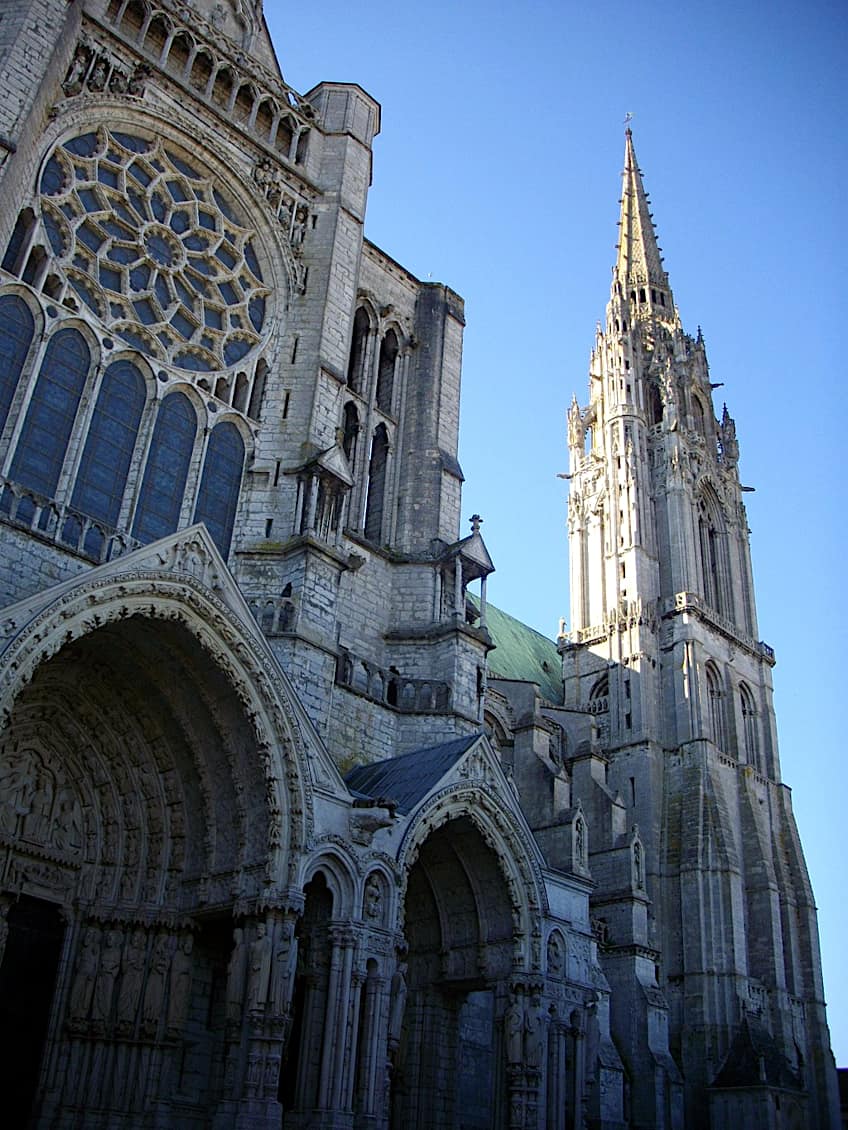
This cathedral was not a new structure. There were about five different cathedrals in the same spot over the centuries. The current cathedral of Chartres is only the latest and longest-lasting of these different cathedrals, and most of those earlier cathedrals, as will be discussed below, were entirely destroyed. However, the cathedral from before the current version was not entirely destroyed and instead adopted and elaborated on in the High Gothic style. That earlier cathedral made use of the Romanesque style. Hence the blending of different types of architecture. This particular cathedral is considered to be one of the most beautiful cathedrals in Europe, and it has even been designated as a World Heritage Site since 1979.
UNESCO, the organization in charge of the World Heritage Sites, even went so far as to call the Chartres Cathedral a masterpiece of French Gothic architecture.
The Chartres Cathedral is particularly well known for the overall unity of its Gothic construction, its extensive use of sculptures, decorative elements, and stained glass. All of these features would go on to heavily influence the Gothic architecture that followed in its wake. The use of stained glass was a particularly strong point for this immensely famous piece of High Gothic architecture.
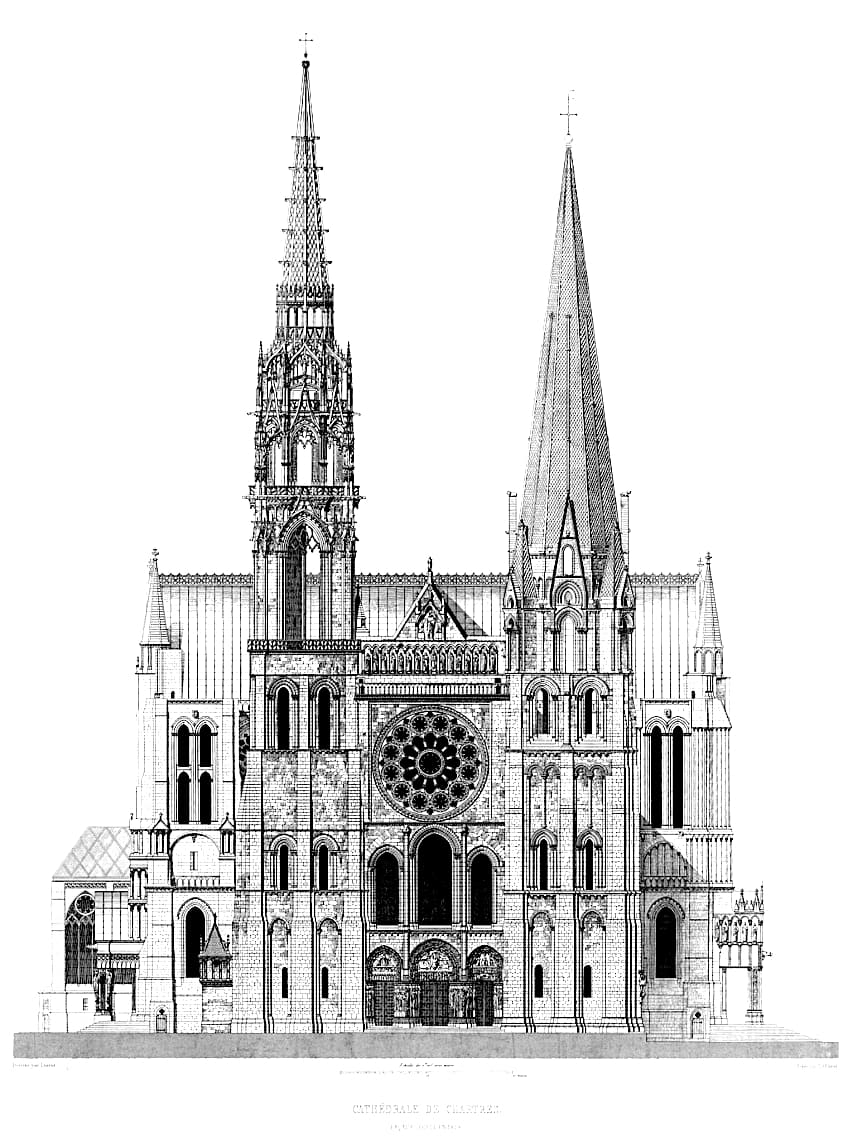
The Characteristics of the Chartres Cathedral
The Chartres Cathedral is a magnificent sight to behold, and it makes use of some of the best examples of Gothic architectural elements that have ever been adopted. This particular cathedral has a vast nave in which the ogival or pointed arches are immensely prominently used. Some sculptures adorn the porches and the stained-glass windows of some of the most striking to have ever been designed. In addition to the beauty of the stained-glass windows, those windows have also managed to withstand the test of time for a very lengthy period. The vast majority of the original stained-glass windows have managed to survive until this day, and there have only been a few minor changes to the structure as a whole since the 13th century.
Those stained-glass windows are also numerous, and they are probably the thing that is most famous about the Chartres Cathedral.
There are 176 different stained-glass windows throughout this classic example of High Gothic architecture. One of the most interesting things about the stained glass that is used in this cathedral is that it was meant to be a lot more than art, but also something educational. It is quite well-known that in the ancient days, the idea of a regular non-aristocratic or non-clerical person learning to read was a bit of a ridiculous notion. There was no need to learn to read when books were prohibitively expensive and usually made use of the kind of language that would require a proper education. If all you did was work on the farm, you had no need for ordinary writing. However, this also meant that regular people could not read the Bible.
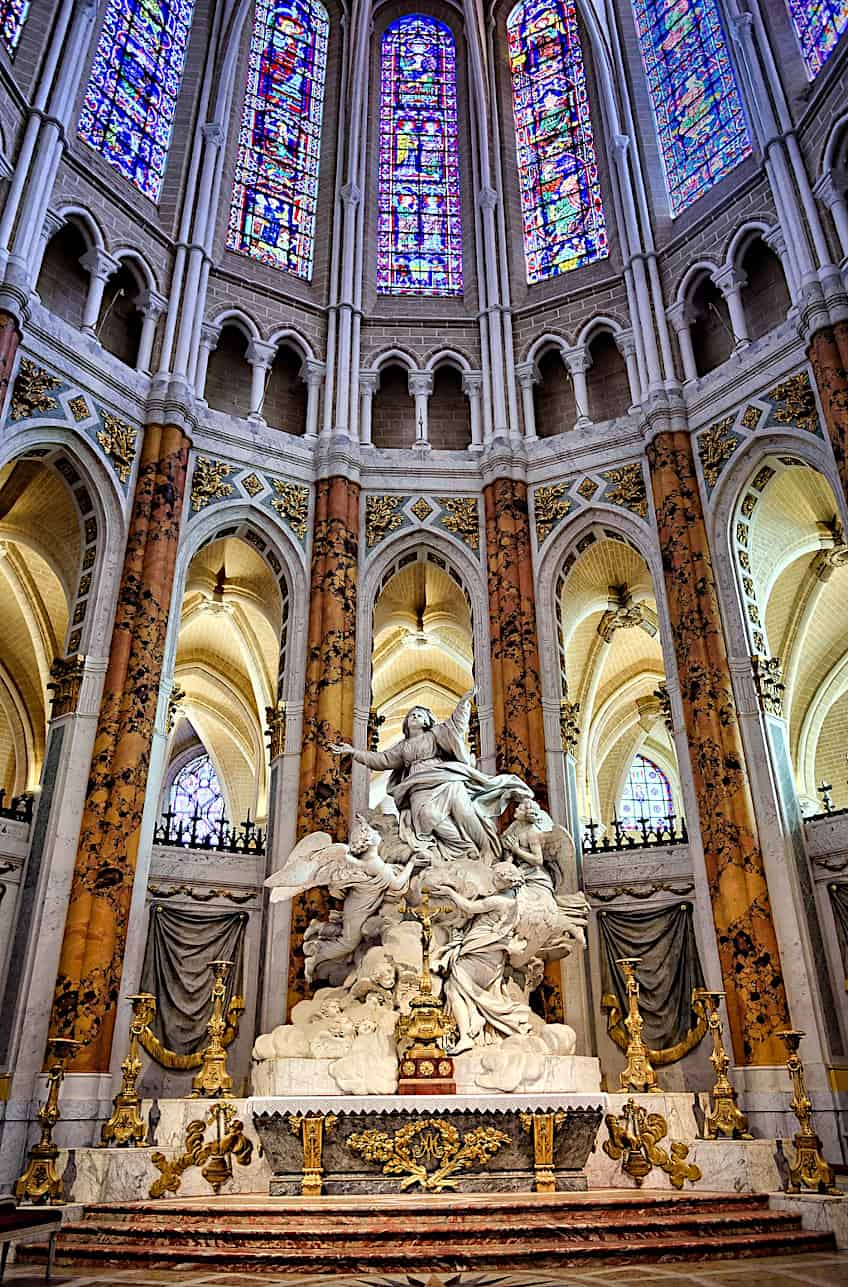
The stained glass in the Chartres Cathedral allowed regular people, who were illiterate, to also engage with the holy book that they worshiped. This stained glass would depict scenes and images from the Bible so that these regular people, the ones who would attend church in that cathedral, could also engage with what they had learned. This is not unique to the Chartres Cathedral but is rather somewhat prominently used in many different stained-glass windows and murals. It was a way to avoid the issue of illiteracy through universally understandable images, and it worked quite well for that purpose.
Outside of the stained glass, both literally and figuratively, the Chartres Cathedral’s exterior makes use of some very common Gothic architectural features.
These characteristics would come to be central defining aspects of Gothic architecture, and these included elements such as the extensive use of flying buttresses to allow for the increase in window size and height, the deployment of two large spires on the western end of the cathedral (although these two spires were constructed at different times and in different styles; the later spire makes use of a Flamboyant style from the 16th century), and there are also three distinct façades that are covered with their own sculpted figures and scenes that aid the stained glass in providing a biblical narrative for those who may not have been able to read.
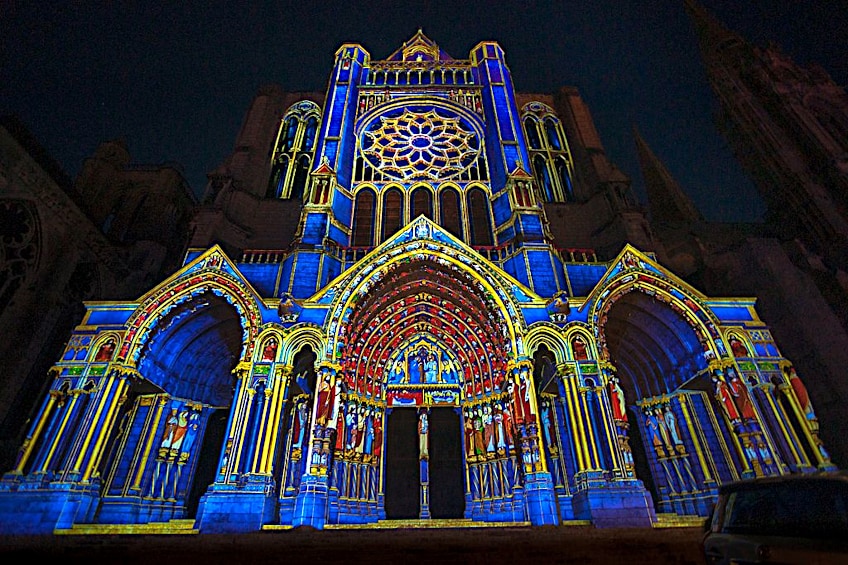
The many sculptures around the Chartres Cathedral are also noted for their immense quality and quantity. This, along with many other elements of this structure, has contributed to it remaining one of the most famous and best-preserved examples of High Gothic architecture and art. There were some changes to the overall structure from 1210-1250, but once those were done, there were hardly any real changes or additions. So, the Chartres Cathedral has remained standing in its present state for hundreds of years with very few changes being made, especially to the base structure. Lastly, it may be worth asking something: What is the Chartres Cathedral made of? What is it actually made of? Not its architectural designs and flourishes, but the building material used to construct it.
Well, it is constructed out of limestone, which was a fairly common building material to use in churches, but what is not fairly common about this particular cathedral is the relic that is housed within its walls. So, what religious relic does Chartres Cathedral house?
The Relic Within the Chartres Cathedral
Religious relics exist within practically every religion, and they are attempts to hold on to some sense of divinity that exists within that particular religious tradition. The authenticity of these relics can often be somewhat dubious as it isn’t all that likely that the kinds of things we typically consider to be special relics would be capable of surviving through thousands of years unscathed. In this particular case, the supposed relic with the Chartres Cathedral is an illustrious one: the tunic worn by the Virgin Mary when she gave birth to Jesus Christ.
This tunic, also known as the Sancta Camisa, would be over two millennia old at this point, but this has not stopped both secular and religious visitors from wanting to have a look at this important Catholic relic.
This particular relic also has a bit of a history behind it as it was purportedly gifted to Chartres by Emperor Charles the Bald in about 876 CE. When there was a later fire in 1194 this relic supposedly survived. It was considered to be utterly miraculous that it had survived at all, but its survival led to further veneration of the ancient relic. However, you may wonder where Charles the Bald got this relic in the first place. Well, he had it because he received it from his grandfather, Charlemagne. Whereas he received it from Irene, the Empress of the Byzantine Empire. Where she got it from, we may never know.
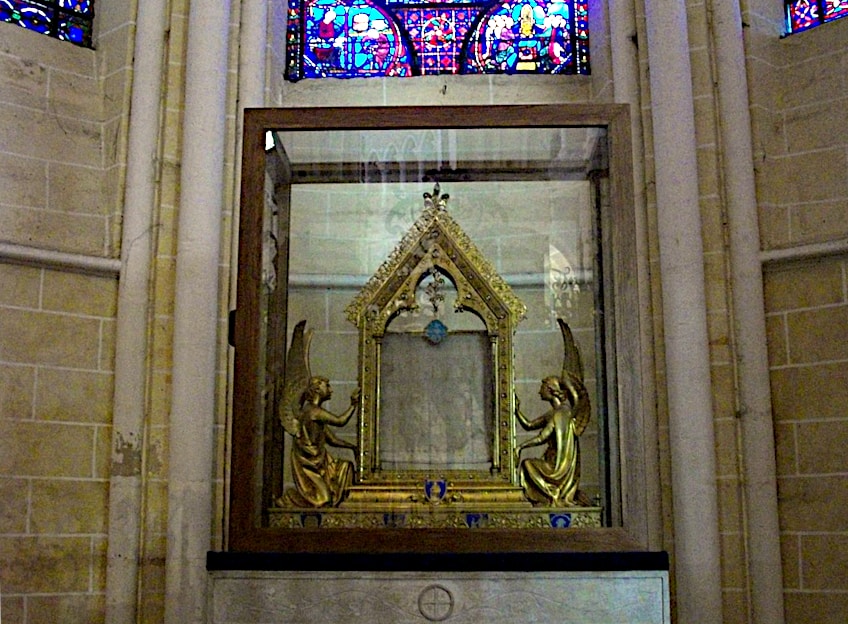
However, to somewhat add to the potential authenticity of this particular relic, it did undergo some testing, and it was determined that it did contain pollen from Palestine in the 1st century CE. So, it clearly is an ancient piece of fabric, but its existence as a divine relic may require a little more faith. Although, regardless of its authenticity, it is an important Catholic relic, and that is why it’s disheartening to know that this relic is no longer in its original state. During the general chaos of the French Revolution, the fabric was cut into pieces and only some of those pieces were later returned. Two of those pieces are currently on display in the Chartres Cathedral.
There is also a smaller piece that is on display in the crypt of the Chapel of Notre-Dame Sous-Terre in Normandy.
The Chartres Cathedral Labyrinth
The Chartres Cathedral labyrinth is another important element of this cathedral. There is a large labyrinth found within the interior of the Chartres Cathedral, and it is rather large in scope. It has a diameter of 12.85 m (or 42 ft) and this makes it the largest of its kind during the medieval era. There are more ornate varieties of this type of religious labyrinth, but this particular one is likely the most famous one in the world. The Chartres Cathedral labyrinth is made up of eleven concentric circles that are argued to represent the spiritual quest of the pilgrim who travels to the holy land. However, we do not know the origins of this particular labyrinth as there are no real records of the construction.
We know that it was added in the first few decades of the 13th century, but we do not know the specifics. This has not stopped people from using it as a holy destination to visit though.
The Chartres Cathedral labyrinth is facilitated by the cathedral itself, and while the actual labyrinth is mostly covered in chairs, as it is used for religious services, it is typically opened up every Friday. This allows anyone to enter the site and follow the pattern. The church has a few rules for the use of this labyrinth, such as noting that it is not for amusement, that you must remove your shoes but not your socks, and that you should not stop while meditatively walking along its lines as others wish to perform their own pilgrimages through the labyrinth.
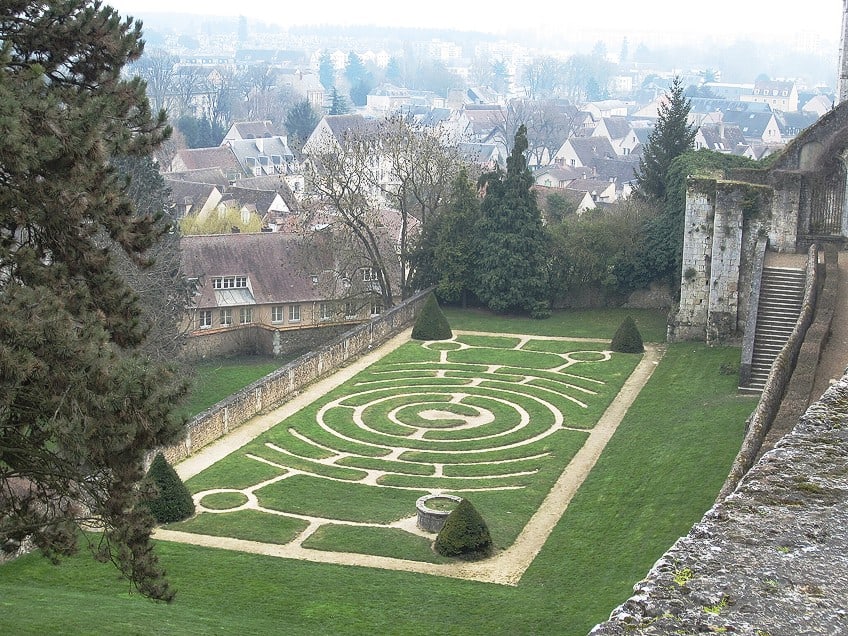
Now, when you first hear about the “Chartres Cathedral labyrinth”, you’re quite likely to picture one of those outdoor labyrinths where the walls are hedges, but while this labyrinth is certainly not one of those, there is still an outdoor version. The outdoor labyrinth at the Chartres Cathedral is far smaller and less elaborate than the interior one, but it can still be walked and examined.
The History of the Chartres Cathedral
The Chartres Cathedral is a magnificent site, but it has a very long history. So, let’s have a look at that history. Before we do that though, it may be pertinent to ask what empire built the Chartres Cathedral. This cathedral is located within France and so it was built under the orders of the Capetian dynasty that ruled France from 987 until the French Revolution. However, their story does not come up much here.
Let’s instead look at the cathedral’s story.
The Cathedrals Prior to the Chartres Cathedral
There were at least five cathedrals in this location before the present one. Each of these new cathedrals was constructed to replace the previous one. For instance, the first church was constructed at some point before the 4th century CE, but it was destroyed in 743 CE by a purposeful fire. The second one also happened to be burned in a fire, but that one was done by Danish raiders in 858. The reconstruction of that church was also destroyed in a fire and then… there was another fire. Basically, this cathedral has had terrible luck with fires. So, preferably don’t bring any matches if you decide to visit.

Ultimately, after so many fires, the present cathedral could finally get underway. This second-to-last cathedral, the one that is partially still standing, was built on the remains of the 9th-century church that preceded it. This church was then constructed in the prevailing Romanesque architectural style of the period.
The Romanesque Origins of the Present Chartres Cathedral
The rebuilding had begun, and there was much public enthusiasm about this brand-new Romanesque cathedral in Chartres. The fires had cleared the way for a far larger and more elaborate structure than had existed before. There were a few changes that were made, some spires were added, and it was going to be a magnificent structure.
It never actually finished completion though because it, once again, caught on fire in 1194.
The High Gothic Reconstruction of the Chartres Cathedral
This fire was devastating, but it did not destroy the entire structure. Instead, it left the crypt, towers, and the newly constructed façade intact. This cathedral had already become an important point for pilgrimage in the country because of the relic within its walls, and so there was immediate financial support to reconstruct the Cathedral of Chartres. This allowed it to begin construction almost immediately after the fire damaged it so immensely.
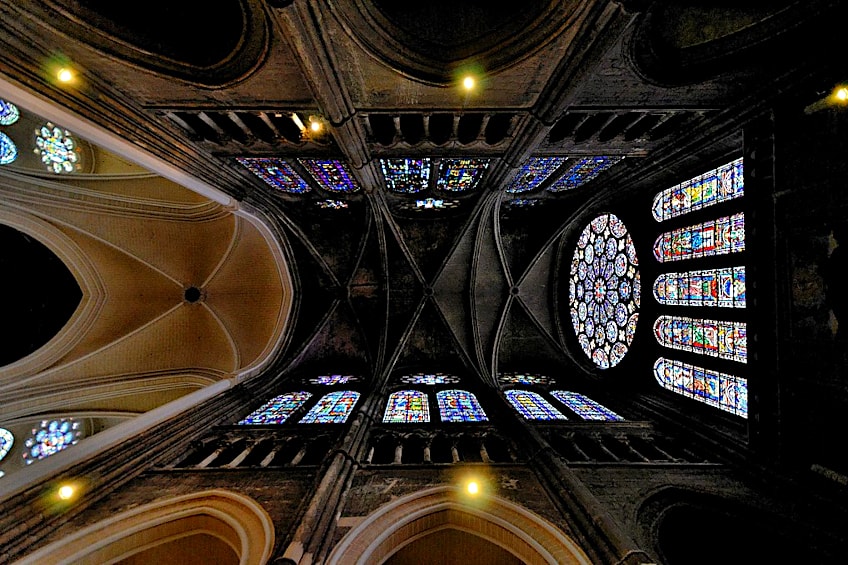
The pieces of Romanesque architecture that had been completed were generally kept in place as they were a part of the construction that had never concluded. However, architectural standards had changed since the older cathedral had started construction, and so some changes were made. The reconstruction did not re-adopt the Romanesque style and instead transitioned towards a High Gothic style. It was formally re-consecrated as a Catholic church in 1260. The Chartres Cathedral was back, and this large series of reconstructions make it difficult to answer the question: When was Chartres Cathedral built? Either way, it was mostly done by 1260.
The Later Additions to the Chartres Cathedral
The Chartres Cathedral was not entirely left alone after it concluded its construction. Instead, it attained a new two-story chapel in 1326, another chapel in 1417, a new spire between 1507 and 1513 (because the previous one got struck by lightning in 1506), and there were a few modifications in 1753 that altered some of the interior decorative elements like the tapestries being replaced with marble reliefs and the pillars being covered in stucco.
However, all of these additions were relatively minor changes to the overall structure of the Chartres Cathedral.
The Influence of the French Revolution on the Chartres Cathedral
Then the French Revolution happened. This period of political and social turmoil also led to the Chartres Cathedral being attacked by a mob of people who started to destroy some of the sculptures. They were stopped, but that did not stop another revolutionary group from planning to destroy the entire cathedral with explosives. They even asked a local architect to help them plan the destruction, but he gave them misinformation about how the rubble from the explosion would damage the surrounding streets and make everything worse. So, sometimes misinformation can be somewhat useful after all.
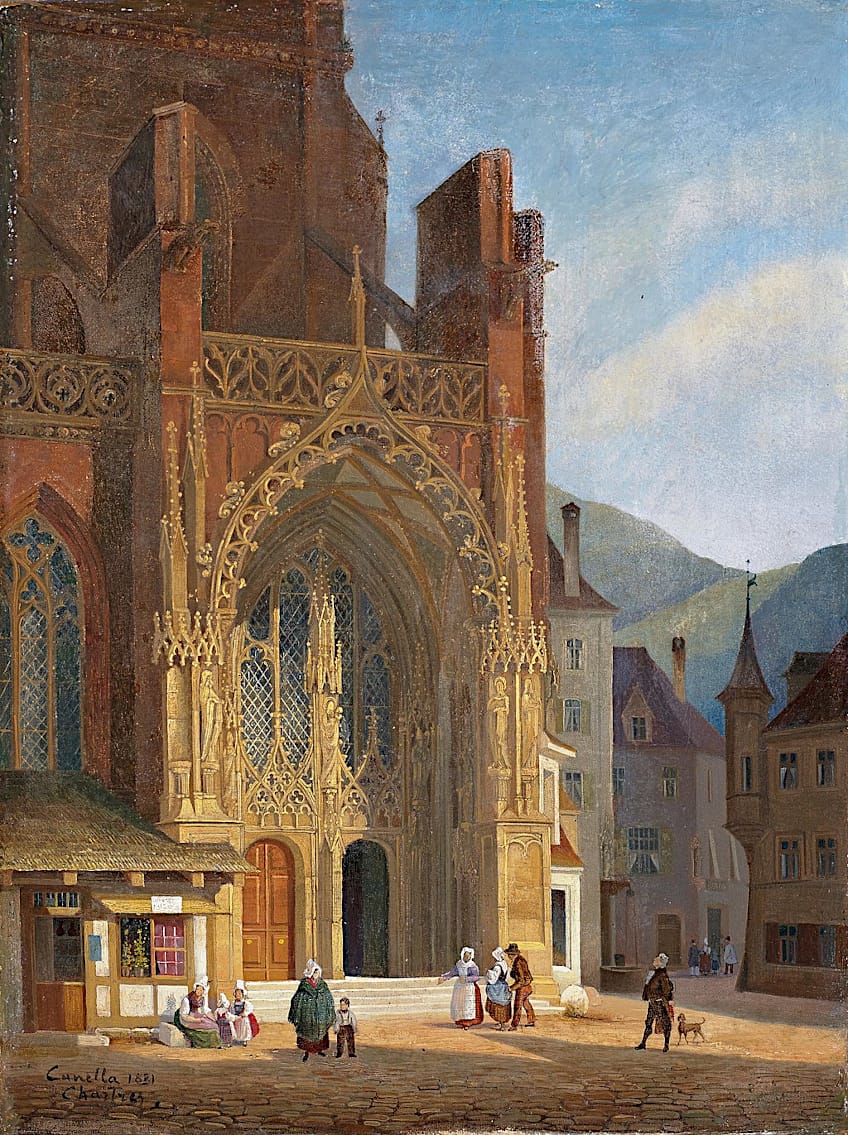
In the aftermath of the French Revolution, the Chartres Cathedral was neglected. There was even a fire in 1836 thanks to this negligence. The roof and two belfries were destroyed, but everything else remained in perfect condition. Regardless of the fire, the stained glass was just fine.
The 20th and 21st Centuries for the Chartres Cathedral
There was one very notable incident in the 20th century. During the Second World War, the cathedral was believed to be occupied by German forces. So, on 16 August 1944, the building was meant to be destroyed by artillery fire. However, an American colonel questioned his orders and instead decided to scout out the building alongside a volunteer soldier. They discovered that the cathedral was empty, so they reported back and the building was not among the architectural casualties of that war. However, that colonel, Welborn Barton Griffith Jr., did not survive that day. He died the same day he saved the Chartres Cathedral from utter destruction.
He was later posthumously awarded numerous military awards by both the American and French governments.

There were no other major incidents thereafter. In 2009, the decision came down to clean the interior and exterior of the structure and to add protective casing to the stained glass. In addition, these $18.5 million renovations painted the interior with the creamy white style that it would have possessed in the 13th century. This would prove controversial, but it is a bit more historically accurate than what had coated the walls before that point.
The Chartres Cathedral is one of the most important of the High Gothic era. It is a magnificent structure complete with a vast array of sculptures and stained-glass windows. This article has looked at the Chartres Cathedral and its primary characteristics, the relic and labyrinth within its walls, and the history of this famous Gothic cathedral. So, hopefully, you have learned a good few things, and we wish you a great day/week/month ahead!
Frequently Asked Questions
Where Was the Chartres Cathedral Built?
The Chartres Cathedral was built in Chartres, hence the name of the cathedral itself. This region is located within the prefecture of the Eure-et-Loir department in the Centre-Val de Loire region of France. It lies about 80 km (or 50 mi) outside of Paris.
When Was Chartres Cathedral Built?
The Chartres Cathedral was constructed in the late 12th and early 13th centuries. This means that it formed part of the Late Romanesque and High Gothic periods of architectural design. It was more specifically constructed in the Romanesque style from 1126, but transitioned to a Gothic style in 1194 and was ultimately completed in 1252. This makes it nearly a thousand years old.
What Empire Built the Chartres Cathedral?
The Chartres Cathedral was constructed during the reign of the French monarchs, specifically the Capetian dynasty. This dynasty was founded in 987 and would only come to a complete end in 1848. It lost power following the French Revolution and was only briefly restored after the fall of Napoleon. The remnants of this dynasty still exist today, but they do not have imperial control over the country any longer.
What Is the Chartres Cathedral Made Of?
The Chartres Cathedral was primarily constructed out of limestone. This is not a particularly unusual construction material for a cathedral. Cathedrals were generally built out of a combination of stone, plaster, and wood. However, the Chartres Cathedral is also immensely well-known for its comprehensive array of stained-glass murals. So, you could argue that glass forms another integral construction material for this famed cathedral.
What Religious Relic Does Chartres Cathedral House?
The Chartres Cathedral holds an important Christian relic within its walls. The Sancta Camisa, also known as the Veil of Mary, is a holy artifact that was supposedly worn by the Virgin Mary during the birth of Jesus Christ. While the authenticity of relics of this variety, especially after it supposedly survived a fire, is dubious, that has not stopped it from being an immensely important sight in this Catholic cathedral.
Justin van Huyssteen is a writer, academic, and educator from Cape Town, South Africa. He holds a master’s degree in Theory of Literature. His primary focus in this field is the analysis of artistic objects through a number of theoretical lenses. His predominant theoretical areas of interest include narratology and critical theory in general, with a particular focus on animal studies. Other than academia, he is a novelist, game reviewer, and freelance writer. Justin’s preferred architectural movements include the more modern and postmodern types of architecture, such as Bauhaus, Art Nouveau, Art Deco, Brutalist, and Futurist varieties like sustainable architecture. Justin is working for artfilemagazine as an author and content writer since 2022. He is responsible for all blog posts about architecture.
Learn more about Justin van Huyssteen and about us.
Cite this Article
Justin, van Huyssteen, “Chartres Cathedral – A Spiritual and Architectural Masterpiece.” artfilemagazine – Your Online Art Source. October 26, 2023. URL: https://artfilemagazine.com/chartres-cathedral/
van Huyssteen, J. (2023, 26 October). Chartres Cathedral – A Spiritual and Architectural Masterpiece. artfilemagazine – Your Online Art Source. https://artfilemagazine.com/chartres-cathedral/
van Huyssteen, Justin. “Chartres Cathedral – A Spiritual and Architectural Masterpiece.” artfilemagazine – Your Online Art Source, October 26, 2023. https://artfilemagazine.com/chartres-cathedral/.


